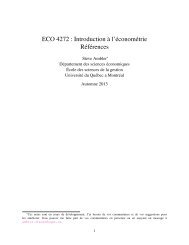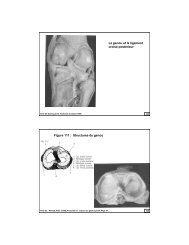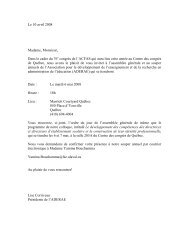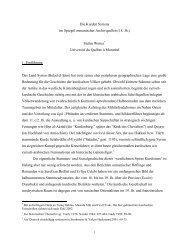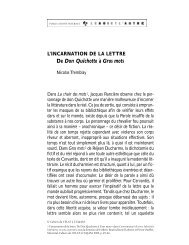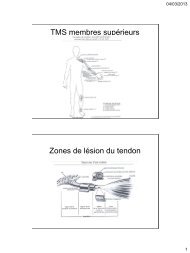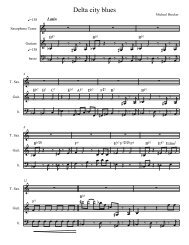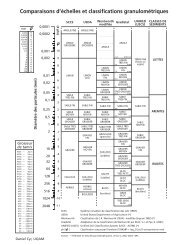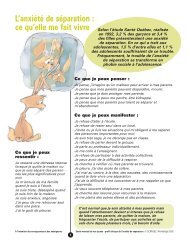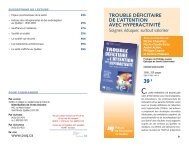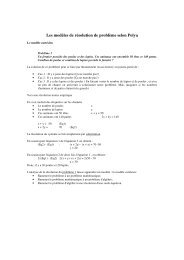Naive, Biased, yet Bayesian: Can Juries Interpret Selectively ...
Naive, Biased, yet Bayesian: Can Juries Interpret Selectively ...
Naive, Biased, yet Bayesian: Can Juries Interpret Selectively ...
You also want an ePaper? Increase the reach of your titles
YUMPU automatically turns print PDFs into web optimized ePapers that Google loves.
JLE0.V12N1 257<br />
<strong>Naive</strong>, <strong>Biased</strong>, <strong>yet</strong> <strong>Bayesian</strong>: <strong>Can</strong> <strong>Juries</strong> <strong>Interpret</strong><br />
<strong>Selectively</strong> Produced Evidence?<br />
Luke M. Froeb<br />
Vanderbilt University<br />
Bruce H. Kobayashi<br />
George Mason University<br />
In an idealized model of civil litigation, interested parties incur costs to produce<br />
statistical evidence. A subset of this evidence is then presented to a naive decisionmaker<br />
(e.g., a jury). The jury is naive in that it views evidence as a random sample<br />
when in fact the evidence is selectively produced. In addition to being narve, the<br />
jury is also biased by prior beliefs that it carries into the courtroom. In spite of the<br />
jury's naivete and biasedness, a full-information decision is reached as long as<br />
both litigants choose to produce evidence. Our results suggest that criticisms of<br />
the jury process based on jury bias or the jury's use of simple or heuristic rules may<br />
be overstated, and underscore the potential importance of competitively produced<br />
evidence in legal decision-making.<br />
1. Introduction<br />
Jury decision-making in civil cases, especially those that involve complex or expert<br />
testimony, has been criticized by lawyers, judges, statisticians, economists,<br />
sociologists, and representatives of just about every other discipline that comes<br />
in contact with the legal system. 1 Defenders of the jury system generally focus<br />
Froeb received research support from the Dean's fund for faculty research at the Owen Graduate<br />
School of Management. Kobayashi received research support from the Law and Economics Center<br />
at George Mason University School of Law. We wish to acknowledge advice about related work<br />
from Cynthia Frobian Williams and editorial help from Lisa Granoien. We also wish to acknowledge<br />
constructive criticism from Timothy Brennan, Stephen Fienberg, Preston McAfee, and Kathryn<br />
Spier. The usual disclaimer must be strengthened here to note that some or all of those mentioned<br />
disagree with our characterization of the adversaria] process.<br />
1. For discussion of the history of the controversy over the merits of using lay juries, see Kal ven<br />
and Zeisel (1966: 4-6) and Simon (1975: 13-18). Among the more outspoken judicial critics of<br />
the jury were Chief Justice Warren Burger and Judge Jerome Frank. For example, in Skidmort v.<br />
Baltimore and Ohio R.R., 116 F.2d 54 (1947), Frank wrote: "While the jury can contribute nothing<br />
of value so far as the law is concerned, it has infinite capacity for mischief, for twelve men can<br />
easily misunderstand more law in a minute than the judge can explain in an hour." Dean Griswold<br />
of Harvard Law School argued: 'The jury trial at best is the apotheosis of the amateur. Why should<br />
anyone think that 12 persons brought in from the street, selected in various ways, for their lack<br />
of general ability, should have any special capacity for deciding controversies between persons?'<br />
(see Guinther, 1988: xiv).<br />
© 1996 by Oxford University Press. All rights reserved. 8756-6222/96/$5.00
258 The Journal o< Law, Economics, 4 Organization, V12 N1<br />
on its use in criminal trials, where juries are seen as a line of defense against the<br />
state's ability to inappropriately deprive individuals of life and liberty. 2 However,<br />
such concerns are viewed as less compelling in civil cases, suggesting<br />
to many critics that the costs imposed by the use of juries on the adjudicative<br />
process outweigh the benefits. 3<br />
Much of the debate has focused on the role of scientific or statistical evidence<br />
in the courts and on the role of experts in the courtroom. 4 Critics suggest that<br />
naive and potentially biased lay juries are inadequately prepared to evaluate<br />
scientific or statistical evidence. 5 Further, critics argue that these problems<br />
are exacerbated by the adversarial presentation of evidence, a process that can<br />
yield selectively produced evidence. Such concerns have led many commentators<br />
to suggest a movement toward neutral nonadversarial proceedings 6 and<br />
to make various proposals for reform, including the elimination of the right<br />
to a jury trial in complex civil cases, 7 increasing the power of judges to prevent<br />
issues from reaching the jury, 8 the appointment of court-appointed experts<br />
or special masters, 9 the constitution of court-approved science panels, 10 fee<br />
2. The right to a jury trial is guaranteed by the Sixth Amendment for criminal trials. The Seventh<br />
Amendment guarantees this right for civil trials where the amount in controversy exceeds $20. For<br />
a discussion of the history of jury trials, see Kalven and Zeisel (1966: 6-8).<br />
3. See the discussion in Cecil, Hans, and Wiggins (1991: 730-31) and Guinther( 1988: xiv).<br />
4. In response to perceived problems faced by the courts in assessing scientific evidence, the<br />
Federal Judicial Center has undertaken and recently published a manual on scientific evidence (see<br />
Federal Judicial Center, 1994 1-4). The issue of admissibility of expert testimony was recently<br />
undertaken by the Supreme Court. See Dauben v. Merrill Dow Pharmaceuticals, 113 S. Ct. 2786<br />
(1993), in which the Supreme Court rejected the general acceptance test of the Frye standard in<br />
favor of the "more liberal" standard under the Rules 702 and 703 of Federal Rules of Evidence.<br />
For discussion of the implications of Daubert, see Parker (1995) and Cecil and Willging (1994b).<br />
5. For proposals to introduce Bayes's theorem into court proceedings to assist the trier of fact, see<br />
Finklestein and Farley (1970) and Wagenaar (1988). For alternative views on this debate, see Tribe<br />
(1971), who suggests that statistical evidence will be given too much weight, and Saks and Kidd<br />
(1981), who suggest that juries underuse such evidence. For evidence that supports the latter view,<br />
see Goodman (1992), Faigman and Baglioni (1988), and references cited therein. For experimental<br />
evidence suggesting that experimental subjects do not conform to a <strong>Bayesian</strong> rule when integrating<br />
probabilities, see Grether (1992), Nisbett and Ross (1980), Tversky and Kahneman (1974); see<br />
also the discussion in Smith (1991) and a survey by Camerer( 1995).<br />
6. See Rubinfeld (1985), Johnston (1988), and Coulam and Fienberg (1986). See also Fienberg<br />
(1989) for a discussion of this issue.<br />
7. For arguments in support of a complexity exception to the Seventh Amendment, see Campbell<br />
(1988) and Campbell and LePoidevin (1980). For arguments that do not support the existence of<br />
such an exception, see Arnold (1980). In addition, the Supreme Court has not incorporated the<br />
Seventh Amendment as applying to the states (see Stone et al., 1991: 784) and has allowed the use<br />
of juries of less than 12 people in federal civil trials [see Colgrove v. Baltin, 413 U.S. 149(1973)]<br />
and in state criminal trials [see Williams v. Florida 399 U.S. 78 (1970)].<br />
8. These devices include expanded use of summary judgment, summary juries, and expanded<br />
use of directed verdicts. For adiscussion of these issues, see Cecil et al. (1991: 736-38).<br />
9. Court appointment of expert witnesses is provided for under Rule 706 of the Federal Rules<br />
of Evidence. Special "reference" masters can be appointed under "exceptional conditions" under<br />
Rule 53(b) of the Federal Rules of Civil Procedure. However, use of court-appointed experts and<br />
non-pretrial special masters has been rare (see Cecil and Willging, 1994a; and Farrell, 1994).<br />
10. See, e.g., Meier (1986).
<strong>Can</strong> Junes Werpret <strong>Selectively</strong> Produced Evidence? 259<br />
shifting," and reform of the discovery rules to include mandatory disclosure<br />
of information. 12<br />
On the other side of the debate are those who offer a "Hayekian" justification<br />
for the adversaria] presentation of testimony to the jury. While both juries<br />
and the adversarial system are inferior to an idealized centralized decisionmaker,<br />
such imperfect decentralized bodies may have inherent advantages over<br />
imperfect centralized decision-makers. 13 Thus, the relevant comparison for<br />
normative purposes is a comparison between the performance of imperfect<br />
institutions. While such a comparative analysis is beyond the scope of this<br />
article, we hope to advance the debate by explicitly modeling the incentives of<br />
the parties to produce costly information and by examining decision-making by<br />
a naive and potentially biased decision-maker faced with selectively produced<br />
evidence.<br />
This article focuses on one aspect of the debate—the ability of juries to competently<br />
evaluate selectively produced statistical evidence. 14 Previous attempts<br />
11. Although the Supreme Court substantially limited the recoverability of expert witness fees<br />
in fee-shifting cases in West Virginia University Hospital v. Casey, 111 S. CL 1138 (1991) (holding<br />
that a provision in 42 U.S.C. §1988 that grants statutory authority for courts to shift "reasonable<br />
attorney's fees" to the losing party does not include expert fees). Congress has recently authorized<br />
the shifting of expert fees by explicitly including such provisions in statutes. Congress chose to<br />
overrule Casey by explicitly authorizing judges to award expert fees in civil rights cases. See the<br />
Civil Rights Act of 1991, Pub. L. No. 102-166, §113(b), 105 Stat. 1071 (1991), 42 U.S.C. §§1988,<br />
2OOOe-5(k)C. Fee shifting of expert fees is also provided in other statutes. For example, the feeshifting<br />
provision in the Clean Air Act, which became the model for nearly identical provisions<br />
in other environmental statutes, states: "The court ... may award costs of litigation (including<br />
reasonable attorney and expert witness fees) to any party, whenever the court determines such an<br />
award is appropriate." See 42 U.S.C. §7604
260 The Journal of Law, Economics, & OrgareaUon, V12 N1<br />
at examining this issue have not considered one or more aspects of this problem.<br />
Gay et al. (1989) consider criminal defendants' choice of judge versus<br />
jury trials. In their model, information processing by juries is assumed to be<br />
"noisier" than information processing by judges. Sophisticated judges and/or<br />
juries draw inferences from both prior information and the defendant's choice<br />
of trial mode. Their analysis does not explicitly model competition between<br />
litigants nor the problem of evidence production. 15<br />
The lines of research most closely related to ours are Sobel (1985) and Milgrom<br />
and Roberts (1986). Sobel (1985) considers the ability of litigants to withhold<br />
evidence in a game in which it is costly to report preexisting evidence. 16<br />
He finds a mixed-strategy equilibrium where a judge maximizes social surplus<br />
by "favoring" one of the litigants with a lower burden of proof. His judge is a<br />
benevolent, sophisticated decision-maker. In this respect our model is more like<br />
that of Milgrom and Roberts (1986) who consider both naive decision-making<br />
and the selective reporting of evidence. In their model, evidence not reported<br />
by one party because it is unfavorable will be reported by the opposing party,<br />
and vice versa. In equilibrium, all relevant information is reported, suggesting<br />
the following equivalence result: an unsophisticated decision-maker faced<br />
with selectively produced evidence will reach a full-information decision, as<br />
long as the litigants' interests are sufficiently opposed. In their model, it is<br />
the competing incentives of the parties, rather than the sophistication of the<br />
decision-maker, that permits a full-information decision.<br />
However, Milgrom and Roberts' model ignores two salient features of the<br />
legal system: the cost of producing evidence 17 and the potential for biased<br />
decision-makers. 18 When evidence is costly to produce, and when parties must<br />
statistical evidence, see Hnklestein and Levin (1990). Evidence from private arbitration suggests<br />
that arbitrators possess neither the characteristics of juries nor those of public judges. That is,<br />
they are neither lay persons nor experts on the law, but rather are chosen based on their familiarity<br />
with the subject matter (see Landes and Posner, 1979). For a model of arbitrator behavior, see<br />
Ashenfelter and Bloom (1984).<br />
15. Because judge trials are assumed to be more accurate, innocent defendants will choose<br />
judge trials, while guilty defendants will prefer juries as long as judges and juries both act naively.<br />
Sophistication on the part of juries will cause all defendants to choose judge trials, while an<br />
equilibrium where judges are sophisticated and juries are not leads to innocent defendants choosing<br />
judges and guilty ones mixing between judges and juries. Gay et al. argue that empirical evidence<br />
on trial outcomes supports the equilibrium generated by naive juries and sophisticated judges.<br />
16. In Sobel's model of dispute resolution, the parties choose between incurring a cost to report<br />
evidence or not reporting evidence to a third-party decision-maker. Sobel also examines how<br />
shifting the burden of proof affects the incentives of the parties to disclose costly information.<br />
However, in Sobel's model, litigants cannot misrepresent their information.<br />
17. Indeed, the perception that litigation under an adversarial system has resulted in excessive<br />
expenditures has been one of the driving forces behind recent attempts at reform, including the<br />
recent amendments to the rules governing sanctions and discovery. For a discussion of these<br />
amendments, see Kobayashi and Parker (1993) and Kobayashi et al. (1994). Other critics of the<br />
adversarial system argue that selective evidence production involves social costs, including the<br />
costly production of misleading information or the costly production of information that is not used<br />
(seeTullock, 1975, 1980).<br />
18. For evidence that experimental jurors make decisions based on nonneutral priors, see Good-
<strong>Can</strong> <strong>Juries</strong> <strong>Interpret</strong> <strong>Selectively</strong> Produced Evidence? 261<br />
overcome bias, not all relevant information will be reported to the decisionmaker.<br />
Instead, the decision of how much evidence to produce depends on the<br />
costs, as well as the benefits, of producing evidence.<br />
In this article, we develop a model that allows for costly evidence production<br />
and decision-maker bias. Despite the added complications, we find that a naive<br />
decision-maker can still reach a full-information decision. There are two forces<br />
at work here: the first is the tendency of the party favored by the underlying<br />
distribution to produce more favorable evidence, due to the lower costs of doing<br />
so; 19 the second is the tendency of the parties to "free ride" on the prior beliefs of<br />
the decision-maker in a way that negates decision-maker bias. In equilibrium,<br />
competition in the selective production of evidence leads to a full-information<br />
decision by a naive and biased decision-maker. We findthat the original intuition<br />
of Milgrom and Roberts about the importance of competition, rather than the<br />
sophistication of the decision-maker, can be extended to situations in which<br />
evidence is costly to produce and to situations in which the decision-maker is<br />
biased.<br />
Our results suggest that the competing incentives of litigants may work to<br />
mitigate some of the potential costs attributed to the use of juries. Consequently,<br />
criticisms of the jury process based on the observation that jurors use<br />
simplifying strategies or heuristics when assessing information may overstate<br />
the shortcomings of lay juries' decision-making abilities. Likewise, experimental<br />
research that does not subject jurors to the competing forces of adverse<br />
litigants and jury deliberations may miss the role these forces play in leading to<br />
accurate decision-making—even by lay decision-makers using simple rules. 20<br />
This finding is similar in spirit to those drawn from experiments conducted in<br />
market settings, which find that individual biases tend to disappear in market<br />
settings. 21 It is also consistent with the large body of empirical research on jury<br />
competence, which, in contrast to the predictions of jury critics, points to the<br />
general competence of the jury. 22<br />
man (1992). The potential for bias is not limited to individual jurors or juries. For a critique<br />
of centralized systems of producing evidence based on bias, see Parker (1995) and McChesney<br />
(1977). Further, asymmetric stakes and asymmetric burdens of proof and other procedural rules<br />
often introduce bias into the litigation process. For an overview of these issues, see Cooter and<br />
Rubinfeld(1989).<br />
19. Our results can be applied to other areas of adversarial litigation where parties expend<br />
resources to affect the probability of victory. Litigation expenditures by competing litigants have<br />
been examined by Tullock (1980), Katz (1988), and Kobayashi and Lott (1996). These models do<br />
not consider the ability of litigants to selectively use information. For models of one-sided litigation<br />
expenditures, see Rubinfeld and Sappington (1987) and Miceli (1990). Our results are also similar<br />
to those found in the literature on asymmetric contests or tournaments (see, e.g., Rosen, 1986; and<br />
Lazear and Rosen, 1981).<br />
20. For examples of experimental design, see Grether (1992); Goodman (19*>2), who incorporates<br />
both types of designs; and Faigman and Baglioni (1988). See also Smith (1991).<br />
21. See, e.g., Camerer (1987), Franciosi et al., (1985), and Forsythe et al. (1991). See Smith<br />
(1991) for a survey of the difference between psychology experimental literature, which focuses<br />
on the individual, and economics experimental literature, which focuses on market settings.<br />
22. The best known empirical study of jury behavior is by Kalven and Zeisel (1966), who report
262 The Journal of Law, Economics, & Organization, V12N1<br />
2. <strong>Naive</strong> and <strong>Biased</strong> <strong>Juries</strong><br />
In this section, we examine the behavior of a jury in the context of an idealized<br />
model of civil litigation where parties have failed to reach out-of-court<br />
settlement and are preparing for trial. 23 The culpability of the defendant is<br />
represented by the mean of a binomial distribution, p, and both parties present<br />
evidence to a jury drawn from this distribution. At issue in the trial is the value<br />
of p. 24 Using the analogy of a coin-flipping experiment, let heads be a piece of<br />
evidence that is favorable to the plaintiff and tails be evidence that is favorable<br />
to the defendant. The parties each report a number of heads and tails to the<br />
jury, and the jury must infer the value of p from the evidence presented in<br />
court. The total evidence reported is {H, T), where H is the number of heads<br />
and T is the number of tails reported by the parties. We explicitly assume that<br />
evidence can be reported in arbitrarily small units so that we can treat {//, 7"}<br />
as continuous. 25<br />
There are several ways to draw inferences about the value of p (Lindley and<br />
Phillips, 1976). Classical inference proceeds from an assumption about the<br />
sample space out of which the evidence is drawn. For example, if the jury<br />
assumed that each party took a fixed number of flips and truthfully reported<br />
the outcomes, then the probability of getting the outcome {//, T] would be<br />
(H : T)p H (] - p) T , where (// : T) denotes the choose function. The method<br />
on the results of the Chicago Jury Project. See also Cecil et al. (1991: 745-64), Simon (1975:<br />
147), and Guinther (1988: 230). These studies generally find that juries are able to comprehend<br />
even complex issues and that there is a high rate of judge/jury agreement. For a recent empirical<br />
study of judge/jury agreement, see Claremont and Eisenbcrg (1992), who find that, contrary to<br />
popular belief, judges are more favorable to plaintiffs in medical malpractice and personal injury<br />
cases than are juries, and that these results are not attributable solely to case-selection effects. See<br />
also Vidmar and Rice (1993).<br />
23. We do not explicitly consider the trial/settlement process in this article. Our main results are<br />
not affected if the assumption that each litigant knows p is changed so that each litigant possesses<br />
only an unbiased estimate of p at the trial/settlement decision. Trials would be generated when<br />
parties' prior estimates of the prior distribution were relatively optimistic (see, e.g., Priest and<br />
Klein, 1984). Further, trials could also be generated even if the parties agree on p—e.g., if the<br />
litigants' differential valuation of precedent causes the absence of a settlement range (see, e.g.,<br />
Kobayashi, 1996; Kobayashi and Lott, 1996; and Rubin, 1977).<br />
24. We assume that accuracy in adjudication is a relevant societal goal, so that the litigants'<br />
increased investment in information is not a social cost. For example, accurate information may<br />
improve individuals ex ante incentives to behave properly, and it may effect marginal deterrence<br />
(see, e.g., Kaplow and Shavell, 1992, 1994; Kaplow, 1994; and Rasmussen, 1992). Uncertainty<br />
can also increase the "option value" of lawsuits, and can increase the number of nonmeritorious<br />
suits (see Cornell, 1990; Landes, 1992; Kobayashi and Parker, 1993). In addition, more accurate<br />
information (i.e., lower variance information) can more effectively offset erroneous prior beliefs<br />
held by the decision-maker. For an analysis of the costs and benefits of competitively versus<br />
centrally produced information, see Froeb and Kobayashi (1993).<br />
25. For the discrete case, in equilibrium, it must be profitable for both litigants to take the last<br />
flip (to get to the optimal stopping point), but unprofitable to flip further. These four conditions<br />
(two for each litigant) characterize the Nash equilibrium, but do not guarantee its existence. In<br />
fact, equilibrium in pure strategies does not always exist unless evidence units become arbitrarily<br />
small. As evidence is measured in smaller and smaller units, the discrete equilibrium converges to<br />
the continuous equilibrium.
<strong>Can</strong> Junes trrtetpret Setectivefy Produced Evidence? 263<br />
of moments estimator is derived from this distribution function:<br />
p = H/(H + T). (1)<br />
Different assumptions about the sample space lead to different estimators, but<br />
some assumptions about the sample space must be made in order to derive an<br />
estimator.<br />
<strong>Bayesian</strong> inference, however, proceeds from different assumptions. The jury<br />
does not need to know the sample space out of which the evidence are drawn,<br />
only that they form an "exchangeable" sequence (Heath and Sudderth, 1976).<br />
Exchangeability means that the sequence of heads and tails is generated "fairly,"<br />
by some experimental process. Unlike classical inference, the exact form of<br />
the experiment need not be known. The jury uses evidence to update its prior<br />
beliefs about the value of p. The estimator of p is the mean of the posterior<br />
distribution. We assume that the jury has a Beta(a, b) prior over the unknown<br />
value of p. The Beta distribution is the conjugate prior 26 to the binomial and is a<br />
function over the interval [0, 1], with mean a/(a+b), that includes the uniform<br />
distribution {a = 1, b = 1) as a special case. The posterior distribution is a<br />
Beta(a + H,b + T) distribution, with posterior mean:<br />
p = {a + H)/(a+b + H + T). (2)<br />
Whether it uses a classical or <strong>Bayesian</strong> approach to infer the value of p,<br />
the jury must make some assumption about the process used by the litigants to<br />
generate the evidence. In the classical case, it is an assumption about the sample<br />
space; in the <strong>Bayesian</strong> case, it is the somewhat less restrictive assumption of<br />
exchangeability. The jury in our model makes one of these two assumptions,<br />
but neither are true. Thus, the jury is "naive" in the sense that it mistakenly<br />
believes or assumes that evidence presented in court is a random or exchangeable<br />
sequence when in fact it is selectively reported by each of the interested parties. 27<br />
The jury's mistaken beliefs about the randomness or exchangeability of the<br />
data means that neither the classical estimator given by (1) nor the <strong>Bayesian</strong><br />
estimator given by (2) can be justified on statistical grounds. The two estimators<br />
discussed above are neither classical nor <strong>Bayesian</strong>, because they are derived<br />
from mistaken assumptions.<br />
In addition to being naive, the jury is "biased" by the prior beliefs that it<br />
carries into the courtroom. We have characterized the bias by a prior probability<br />
distribution over the unknown value of p. Although juries in civil case s<br />
are supposed to choose a decision rule according to a "preponderance of the<br />
evidence" standard, there are no sanctions for behaving otherwise, and jury<br />
26. We choose a Beta distribution because it is the only distribution that allows an analytic<br />
solution for the posterior mean. Other prior distributions are possible, but the posterior mean could<br />
only be calculated numerically. The results that follow depend critically on the functional form of<br />
the posterior mean that derives from the use of the Beta prior.<br />
27. For research suggesting that experimental jurors fail to appropriately combine evidence, see<br />
the references contained in note 20, supra.
264 The Journal of Law, Economics, & Organization, VI2 N1<br />
bias is a well known phenomenon. 28 We explicitly allow for jury bias through<br />
the parameters {a, b}. A jury with a prior such that a > b (a < b) favors the<br />
plaintiff (defendant). Large values of a orb mean that the jury's prior beliefs are<br />
very strong, or that it is less likely to be swayed by evidence presented in court. 29<br />
For example, a jury with [a = 2, b — 2} has the same prior mean as a jury<br />
with {a — 1, b = 1} but is less easily swayed by evidence produced in court.<br />
This is seen by examining the variance of the Beta(a, b) prior distribution,<br />
ab/((a+b) 2 (l +a+b)). Using our examples, the variance of the Beta(2, 2) is<br />
^ while the variance of the Beta(l, 1) is ^. A smaller prior variance signifies<br />
stronger prior beliefs.<br />
The jury behavior described above can be characterized completely by the<br />
single estimator given in Equation (2), p — (a + H)/(a + b + H + T).<br />
The classical estimator given in Equation (1) is a special case of the <strong>Bayesian</strong><br />
estimator, characterized by the parameters {a = 0, b — 0}. The classical<br />
estimator can also be motivated as a "split the difference" decision rule. The<br />
classical estimator does not require that the jury use any type of formal statistical<br />
inference—it can be generated by a jury that uses a simple weighting scheme<br />
to evaluate the competing claims of the litigants.<br />
3. Competitively Produced Evidence<br />
In this section, we model the behavior of a defendant and plaintiff who are<br />
preparing for trial, facing a naive and biased jury. As mentioned above, we<br />
allow the parties to attempt to mislead the jury by selectively reporting favorable<br />
evidence. Continuing with the coin-flipping analogy, the plaintiff is allowed to<br />
report a favorable subset of the flips taken, as is the defendant. As it turns out,<br />
neither party has an incentive to report unfavorable flips—that is, the plaintiff<br />
reports only flips that come up heads, and the defendant reports only those that<br />
come up tails. This feature comports well with the observation that litigants<br />
rarely report unfavorable evidence (e.g., Rubinfeld, 1985). In addition, we<br />
assume that evidence is costly to produce, according to the number of flips that<br />
each party decides to take.<br />
This assumption of costly evidence production differentiates our approach<br />
from that of Milgrom and Roberts (1986), who study litigation under the assumption<br />
that parties can costlessly and credibly produce and report evidence.<br />
In their model, evidence not reported by one party would be reported by the<br />
other, and vice versa. In equilibrium, all relevant evidence would be reported—<br />
that is, the jury would know the exact value of p. In contrast, we consider a<br />
different type of evidence: that which is costly to produce and which cannot<br />
be costlessly revealed. In our model, for any party to reveal the exact value of<br />
p would require an infinite number of flips, a prohibitively costly undertaking.<br />
While Milgrom and Roberts's assumption is probably best suited to evidence<br />
28. See the discussion in note 14, supra.<br />
29. Bias can also be imposed by varying the standard of proof. For discussion of this issue, see<br />
Sobel (1985), Rubinfeld and Sappington (1987), Davis (1994).
<strong>Can</strong> <strong>Juries</strong> <strong>Interpret</strong> <strong>Selectively</strong> Produced Evidence? 265<br />
that can be costlessly reported, our assumption is better suited to more costly<br />
types of evidence, the archetypal example being that of expert testimony. 30<br />
Continuing with the coin-flipping analogy, the number of flips is analogous to<br />
the effort that it takes to produce favorable evidence. For example, the plaintiff<br />
produces evidence of quantity H after, on average, H/p flips. Similarly, the<br />
defendant produces evidence of quantity T after, on average, T/(\ — p) flips.<br />
We are implicitly assuming that the jury can verify that evidence is drawn from<br />
the distribution of interest but cannot verify the existence of unfavorable, and<br />
unreported, evidence. 31<br />
One can immediately see that for p > .5, when the plaintiff is favored by<br />
the distribution, the plaintiff will have to flip fewer times, on average, than the<br />
defendant, to produce evidence of equal strength {H — T). If, as we postulate,<br />
evidence is costly to produce (according to the number of flips) then for p > .5,<br />
it is more costly, on average, for the defendant to produce evidence of the same<br />
strength as evidence produced by the plaintiff. This difference in cost turns<br />
out to be important because it induces the party favored by the distribution to<br />
produce more favorable evidence than the opposition.<br />
Formally, suppose we interpret p as the defendant's level of fault under a<br />
comparative negligence tort standard. The plaintiff's award equals pS, where<br />
p is the jury's estimate of the true p, and S is the amount of harm, which is<br />
assumed to be uncontested. Given the jury's weighting scheme, the decision of<br />
how much evidence to produce becomes an optimal stopping problem for each<br />
of the litigants. The parties stop producing evidence when they have "enough"<br />
favorable evidence. 32 The effort that it takes to produce evidence is a random<br />
30. A distinction between the two types of evidence can be made on the basis of Hirschleifer's<br />
classic separation of information into "foreknowledge" and "discovery." The former type of information<br />
is either preexisting or inelastically supplied, while the latter type of information can be<br />
produced only with costly effort (see Hirshleifer, 1971). For discussion of this in the context of<br />
legal issues, see Easterbrook (1981), Kaplow and Shavell (1989), and Allen et al. (1990) regarding<br />
legal privileges; Kobayashi et al. (1994) on mandatory disclosure; and Parker (1995) and Froeb<br />
and Kobayashi (1993) on expert testimony.<br />
31. While the recent amendments to discovery practice under the Federal Rules of Civil Procedure<br />
attempted to reduce a litigant's ability to hide information, hiding unfavorable expert information<br />
generally can be accomplished by hiring multiple experts and selecting for trial those with favorable<br />
results. Under Rule 26(b)(4) of the Federal Rules of Civil Procedure, the ability of a party "to<br />
discover facts known or opinions held by an expert who has been retained or specially employed<br />
by another party in anticipation of litigation or preparation for trial and who is not expected to be<br />
called as a witness at trial" is severely limited. See Johnston (1988) for a discussion of the practice<br />
of "expert shopping." For a discussion of the amendments to the discovery rules, see the discussion<br />
in note 12, supra.<br />
32. When the distribution is unknown to the litigants, flipping takes on an "option" value. Using<br />
the intuition of Roberts and Weitzman (1981), if the uncertainty is large relative to the cost of<br />
flipping, litigants will always take a few initial flips because it gives them the option of flipping<br />
more if they learn that the distribution is favorable. In our model, this would change the nature of<br />
equilibrium for cases in which one of the litigants would not flip, absent the option value of flipping.<br />
It would move the estimator further away from the true value toward the prior mean. However, when<br />
the cost of flipping is low, Rothschild (1974) finds that for the Dirichelet/multinomial conjugate<br />
distributions, which are generalizations of the beta/binomial, "not invariably, but in many instances"
26 The Journal of Law, Economics, 4 Organization, V12N1<br />
variable, but we assume that the parties are risk neutral, so they care only about<br />
the mean level of effort required to produce favorable information and not about<br />
variance in the level of effort. Under these assumptions, the litigants choose<br />
stopping values, {//*, T*\, which satisfy<br />
H* = argmaxf/55 1 - cH/p] such that H > 0, (3a)<br />
T* = argmax[-pS-cT/(l - p)] such that T > 0, (3b)<br />
where c is the cost of flipping and p - (a + H)/(a + b + H + T). For H > 0<br />
and T > 0, this litigation game has a unique 33 Nash equilibrium:<br />
{//*, r} = [-a + P 2 {\ - p)S/c, -b + (\- p) 2 pS/c)<br />
if H* > 0 and T* > 0.<br />
(4a)<br />
The notable thing about this equilibrium is that when both plaintiff and defendant<br />
produce strictly positive amounts of evidence, the estimator used by the<br />
jury is exact—that is,<br />
p* = H*I(H* + T*) = p. (5)<br />
Note that there is no variance to the estimator given by Equation (5). There<br />
is variance in the number of flips required to produce the estimator, but not<br />
in the estimator itself. Thus, when evidence is produced by both sides, the<br />
adversarial process and the naive jury produce a costly but accurate (unbiased<br />
and zero variance) estimate. We say it is "costly" because the litigants throw<br />
away information (unreported flips), but the reported flips are produced in<br />
exactly the "right" proportion.<br />
There are two forces at work here. First is the tendency of the party favored<br />
by the distribution to produce more favorable evidence, due to the lower costs<br />
of doing so. Second, is the tendency of the parties to "free ride" on the prior<br />
beliefs of the jury. When the jury has prior beliefs that favor one party, that<br />
party produces less evidence, which exactly counteracts the effects of the prior<br />
beliefs of the jury. This happens because jury bias lowers the marginal benefit<br />
of flipping, reducing by a the number of heads produced by the plaintiff and<br />
by b the number of tails produced by the defendant. Effectively, the jury's<br />
bias gives a "head start" to one side—it is as if they were endowed with some<br />
free evidence. And in equilibrium, when both parties choose to flip, jury bias<br />
disappears.<br />
Note that this "exactness" result depends explicitly on our characterization<br />
of the unequal costs of producing evidence as a negative binomial experiment.<br />
The litigant favored by the distribution has a lower marginal cost of evidence<br />
the distribution is "learned" as more draws are taken so that the stopping rule is similar to that used<br />
when the distribution is known in advance. For recent review of optimal stopping, see McMillan<br />
and Rothschild (1994).<br />
33. The uniqueness of the equilibrium is proved in the Appendix.
<strong>Can</strong> <strong>Juries</strong> <strong>Interpret</strong> Setecttajry Produced Evidence? 267<br />
production, and therefore flips more in equilibrium. The equal marginal costs<br />
of flipping, as opposed to the unequal costs of evidence production, can be<br />
justified by assuming a competitive market for expert coin-flippers. An expert<br />
charging a supracompetitive rate would not attract any clients.<br />
To illustrate the equilibrium, we present a numerical example. Suppose that<br />
the true p equals |, so that the plaintiff is favored by the distribution, and the<br />
jury has a uniform prior over the unknown p, that is, [a = 1, b — 1}. Suppose<br />
further that the amount at risk is $2,000,000, and the cost of flipping is $ 100,000.<br />
In equilibrium the plaintiff reports 1.96 heads, and the defendant reports 0.48<br />
tails. On average, the plaintiff will take 2.94 flips, costing $294,000, and<br />
the defendant 1.44 flips, costing $144,000. The jury's estimate of p is exact:<br />
(1 + 1.96)/(2 + 1.96 + 0.48) = .667.<br />
When p is close to zero, or one, the marginal benefit of flipping is so small<br />
that the party favored by the distribution takes no flips. In this case, the Nash<br />
equilibrium takes the following form, depending upon who decides not to flip:<br />
{//'*, T**) = {-a-b + (l/c)(-ac(l - p)) l/2 ,0) if 7"* < 0 (4b)<br />
= {0, -a - b + (\/c)(bcpS) l/2 } if H* < O.(4c)<br />
The stronger the beliefs of the jury—that is, the larger are {a, b]—the fewer flips<br />
the respective parties take. A party produces no evidence when the bias of the<br />
jury is strong, and when p is near zero or one. In this case the marginal benefit<br />
of flipping is so small, that it is better to not flip at all. When this happens,<br />
the opposing litigant decides to flip more because the reaction functions of the<br />
litigants are upward sloping. The net effect of these changes is to bias the<br />
estimator of the jury toward the prior mean of the jury. Note that although<br />
the estimator is biased, it represents a improvement relative to the no-evidence<br />
case, because it moves the jury's estimator from the prior mean toward the<br />
true p.<br />
The Nash equilibrium is illustrated for all possible p values in three different<br />
cases for S = $2,000,000 and c = $100,000: in Figure 1, [a = 1, b = 1);<br />
Figure 2, {a = 2, b = 1}; and Figure 3, {a = 0, b = 0}. In all three figures,<br />
the true value of p is on the horizontal axis; the top graph plots the number of<br />
heads and tails reported by the litigants; and the bottom graph plots the value<br />
of the jury's estimator relative to the true value of p. In Figure 1, the jury has a<br />
uniform prior over the unknown value of p. In the top graph of Figure 1, when<br />
the value of p is near zero, only the plaintiff flips, and the jury's estimator of<br />
p is biased toward the prior mean. The jury's prior is represented by a dashed<br />
horizontal line. The bias is represented in the bottom graph as a deviation from<br />
the 45 degree line. As p increases, when the defendant begins flipping, the<br />
jury's estimator becomes exact—that is, p* — H*/(H* + T*) = p. As p<br />
approaches one, the plaintiff stops flipping, and the jury's estimator is again<br />
biased toward the prior mean.<br />
The effects of jury bias are illustrated in Figure 2, where the jury's prior
268 The Journal of Law, Economics, & Organization. V12 N1<br />
2.5<br />
1.5<br />
0.5<br />
Heads<br />
Tails<br />
0.2 0.4 0.6 0.8<br />
0.8<br />
true p<br />
jury's p<br />
jury's prior<br />
0.6<br />
0.4<br />
0.2<br />
0.2 0.4 0.6 0.8<br />
Figure 1. Effects on evidence when jury has uniform pnors: {a = 1, b = 1).<br />
favors the plaintiff. Here the plaintiff "free rides" on the jury's stronger prior,<br />
and doesn't begin flipping until a much higher value of p. This means that<br />
there is a larger range over which the jury's estimator is biased toward the prior<br />
mean |, but, as above, when both parties produce evidence, bias disappears. 34<br />
34. Note that, in the cases illustrated in Figures 1 and 2, a corner solution is reached (i.e., one<br />
of the parties produces no evidence). When p is close to zero or one, there is bias, but not in<br />
cases where p is "close" to ,5. According to the Priest and Klein (1984) model of litigation versus<br />
settlement, the selection of cases for litigation will be biased toward cases where p is close to .5.
<strong>Can</strong> <strong>Juries</strong> <strong>Interpret</strong> Selectfvety Produced Evidence? 269<br />
3<br />
2.5<br />
X<br />
X<br />
X<br />
2<br />
X<br />
X<br />
1.5<br />
X X ^ ,<br />
1<br />
0.5<br />
Heads<br />
Tails<br />
J<br />
0.2 0.4<br />
0.6 0.8 1<br />
0.8<br />
true p<br />
jury's p<br />
jury's prior<br />
0.6<br />
0.4<br />
0.2<br />
0.2 0.4 0.6 0.8 1<br />
Rgure 2. Effects on evidence when jury's prior favors the plaintiff: {a = 2, b = 1).<br />
The net effect of the adversarial system is to mitigate the prior bias of the jury.<br />
This is seen in the bottom graph in Figure 2 where the jury's estimator is closer<br />
to the true p than is the prior mean of the jury. Even though the jury's estimator<br />
is biased, it is a better estimator than the prior mean of the jury.<br />
See the discussion in note 23, supra. Thus, under the Priest-Klein hypothesis, the set of litigated<br />
cases will be relatively free of bias. However, the amount paid in settled cases (those where p is<br />
close to zero or one) will reflect the jury's bias.
270 The Journal of Law, Economics, 4 Organization, V12 N1<br />
The "classical" jury is illustrated in Figure 3 {a — 0, b — 0}. In this case,<br />
the estimator used by the jury is exact, no matter what the value of p, because<br />
there is no region where the parties do not flip. 35<br />
4. Conclusions<br />
The exactness of the jury's estimator is sensitive to a number of assumptions,<br />
implicitly associated with the functional forms used in the model. The payoff<br />
functions, 36 the way bias is modeled, the simultaneous presentation of evidence,<br />
the specific distributional assumptions used, and the assumption of constant<br />
marginal costs of flipping 37 are all critical to the results of the model. Though<br />
stylized, our model of litigation captures four salient features of the legal system:<br />
competition between the litigants, selective production of favorable evidence,<br />
costly production of evidence, and a naive and biased decision-maker. Our<br />
results suggest that, in equilibrium, the decision-maker is able to overcome<br />
these shortcomings and reach a full-information decision when both parties<br />
choose to produce evidence. This implies that competitively produced evidence<br />
in an adversaria] setting may mitigate some of the costs attributed to decision-<br />
35. Note that in the case of the classical jury (Figure 3), a tax on evidence will increase welfare,<br />
as the amount of evidence and thus the costs of producing evidence will fall. However, this is not<br />
true in the cases set out in Figures 1 and 2. In these cases, a tax on evidence will increase the range<br />
over which one party produces no evidence. Although evidence production costs are lower, the<br />
accuracy of the estimator will decrease. Further, given the assumption of the model, the additional<br />
bias will be predictable ex ante, thereby affecting both settlement and ex ante behavior.<br />
36. Fee shifting, or "loser pays" rules, arc somewhat difficult to address in the context of this<br />
model because of the discarded unfavorable evidence. If one of the litigants winds up paying<br />
the other's legal costs, the payer would presumably learn about the other's discarded evidence. In<br />
addition, the fee shifting used in England and Rule 68 of the Federal Rules of Civil Procedure apply<br />
only to marginal expenditures incurred following an offer of judgment. Since we do not model<br />
settlement, it is difficult to evaluate these rules in the context of our model. However, putting<br />
these considerations aside, with fee shifting the party disfavored by the distribution produces no<br />
evidence, because fee shifting leads to more costly evidence production for which he will likely<br />
end up paying. This leads to a bias in the jury's estimator, in favor of the litigant favored by the<br />
distribution. For discussions of similar effects of fee shifting on the rates of filings, settlement, and<br />
trial, see Shavell (1982).<br />
37. With rising marginal costs (with the number of flips), the nature of optimal search changes for<br />
the parties. No longer are open- and closed-loop strategies equilvalent (McMillan and Rothschild,<br />
1994; Roberts and Weitzman, 1981). If the litigants stop and reoptimize, the optimal numberofflips<br />
changes because the marginal conditions are likely to change. If for example, the plaintiff started<br />
off with an unlucky streak (no heads), he would end up settling, on average, for fewer heads than<br />
he would have produced following an open-loop strategy (computed before any flips were taken).<br />
This changes the nature of the equilibrium by introducing variance into the estimator of the jury.<br />
Sometimes the plaintiff will get lucky and sometimes the defendant will get lucky. On average,<br />
the "luck" will balance out, but this is difficult to prove analytically because closed-loop equilibria<br />
arc difficult to compute. Instead, we have examined open-loop equilibria as an average benchmark<br />
for the closed-loop equilibria in the rising marginal costs case. We find that the principal accuracy<br />
result for the constant-cost case is robust with respect to rising marginal costs for the "classical"<br />
estimator but not for the "<strong>Bayesian</strong>" estimator. For a ^ 0 or b ^ 0, we find that while the jury's<br />
estimator is close to the true p, it is not exact.
<strong>Can</strong> <strong>Juries</strong> <strong>Interpret</strong> <strong>Selectively</strong> Produced Evidence? 271<br />
2.5<br />
1.5<br />
0.5<br />
0.2 0.4 0.6 0.8<br />
true p<br />
0.8<br />
jury's p<br />
0.6<br />
0.4<br />
0.2<br />
0.2 0.4 0.6 0.8 1<br />
Figure 3. Effects on evidence for a "classical" jury, one that has no priors: {a = 0, b = 0).<br />
maker bias and to the use of simplified rules or heuristics to evaluate selectively<br />
produced information.<br />
Appendix: Characterization of Nash Equilibrium<br />
This section characterizes the Nash equilibrium of the litigation game in the<br />
case where evidence is continuous, or measured in small enough units to be<br />
effectively continuous. In essence, we permit litigants to present "pieces" of<br />
evidence, like 2.94 heads. In this case, the expected payoff vector to the plaintiff
272 The Journal of Law, Economics, & Organtzaflon, V12 N1<br />
and defendant is<br />
[pS-cH/p,-pS-cT/{l-p)}.<br />
The first derivatives whose roots characterize a Nash equilibrium are<br />
{-{c/p) - ((a + H)*S)/(a + b + H + T) 2 + S/(a + b + H + T),<br />
c/(-l + P) + ((a + H)*S)/{a +b + H + T) 2 }.<br />
The roots of these derivatives have an explicit solution, given in Equation (4a),<br />
which we reproduce below.<br />
{H\ r} = {-a + P 2 {\ - p)S/c, -b + 0- pfpS/c)<br />
if H* > 0 and T* > 0<br />
(4a)<br />
That this solution is unique can be seen by examining the matrix of second<br />
partial derivatives of the payoff vector.<br />
{{(-2*S'{b + T))/(a +b + H + T) 3 ,<br />
(S*(a -b + H - T))/(a +b + H + T) 3 },<br />
[(S*(-a + b- H + T))/{a + b + H + T)\<br />
(-2*(a + H)*S)/(a +b + H + T) 3 }}.<br />
The determinant of this matrix is equal to S 2 /(a +b + H + T) A . For H > 0,<br />
T > 0, it is seen that the principal minors alternate in sign, implying that the<br />
matrix is negative definite, which guarantees that the solution given in (4a) is<br />
unique.<br />
When the constraints, H > 0 or T > 0, are binding, we compute the Nash<br />
equilibria by first computing the reaction functions implied by the derivatives<br />
of the payoff vector:<br />
{-a - b - T + (c*p*S*(b + T)) l ' 2 /c,<br />
-a-b-H<br />
The reaction function of the nonconstrained litigant is positively sloped in the<br />
region of interest, so for p's near zero, where the plaintiff would like to produce<br />
negative amounts of evidence (sell evidence to the experts) but must produce<br />
more evidence (zero), the defendant produces more than he would like in an<br />
unconstrained equilibrium. Substituting the constraints into the appropriate<br />
reaction functions leads to the constrained equilibrium represented by Equations<br />
(4b) and (4c), which we reproduce below:<br />
{//**, 7"} = {-a- b + (\/c)(-ac(\ -p)) l/2 ,0} \fT*
<strong>Can</strong> <strong>Juries</strong> <strong>Interpret</strong> <strong>Selectively</strong> Produced Evidence? 273<br />
Arnold, Morris S. 1980. "A Historical Inquiry into the Right to Trial by Jury in Complex Civil<br />
Litigation," 128 University of Pennsylvania Law Review 829—48.<br />
Ashenfelter, Orley, and D. E, Bloom. 1984. "Models of Arbitrator Behavior," 74 American<br />
Economic Review 111-24.<br />
Bcrsoff, Donald N., and David J. Glass. 1995. The Not So Weisman: The Supreme Court's<br />
Continuing Misuse of Social Science Research," 2 University of Chicago Law School Roundtable<br />
279-300.<br />
Camerer, Colin. 1987. "Do Biases in Probability Judgment Matter in Markets? Experimental<br />
Evidence," 77 American Economic Review 981-97.<br />
1995. 'Individual Decision Making," in John Kagel and Alvin Roth, eds., Handbook of<br />
Experimental Economics. Princeton, N J.: Princeton University Press.<br />
Campbell, James S. 1988. "The Current Understanding of the Seventh Amendment," 66 Washington<br />
University Law Quarterly 63-70.<br />
, and Nicholas LePoidevin. 1980. "Complex Cases and Jury Trials: A Reply to Professor<br />
Arnold," 128 University of Pennsylvania Law Review 965-85.<br />
Cecil, Joe S., Valerie P. Hans, and Elizabeth C. Wiggins. 1991. "Citizen Comprehension of Difficult<br />
Issues: Lessons from Civil Jury Trials," 40 American University Law Review 727-74.<br />
, and Thomas E. Willging. 1994a. "Court-Appointed Experts," in Federal Judicial Center,<br />
Reference Manual on Scientific Evidence. Colorado Springs, Col.: Shepard's McGraw Hill.<br />
, and 1994b. "Accepting Daubert's Invitation: Defining a Role for Court-Appointed<br />
Experts in Assessing Scientific Validity," 43 Emory Law Journal 995—1070.<br />
Claremont, Kevin M., and Theodore Eisenberg. 1992. "Trial by Jury or Judge: Transcending<br />
Empiricism," 77 Cornell Law Review 1124-77.<br />
Cooler, Robert D., and Daniel L. Rubinfeld. 1989. "An Economic Analysis of Legal Disputes and<br />
their Resolution," 27 Journal of Economic Literature 1067-97.<br />
, and 1994. "An Economic Model of Legal Discovery," 23 Journal of Legal Studies<br />
435-64.<br />
Cornell, Bradford. 1990. "The Incentive to Sue: An Option Pricing Approach," 19 Journal of Legal<br />
Studies 173-89.<br />
Coulam, Robert, and Stephen Henberg. 1986. "The Use of Court-Appointed Statistical Experts: A<br />
Case Study," in M. H. DeGroot, S. E. Fienberg, and J. B. Kadane, eds., Statistics and the Law.<br />
New York: Wiley.<br />
Davis, Michael L. 1994. "The Value of Truth and Optimal Standard of Proof in Legal Disputes,"<br />
10 Journal of Law, Economics,
274 The Journal of Law, Economics, 4 Organization, V12 N1<br />
Froeb, Luke M., and Bruce H. Kobayashi. 1993. "Competition in the Production of Costly<br />
Information: An Economic Analysis of Adversarial versus Court Appointed Presentation of<br />
Expert Testimony," Law and Economics Working Paper No. 93-005, George Mason University<br />
School of Law.<br />
Gay, Gerald D., Martin F. Grace, Jayant R. Kale, and Thomas H. Noe. 1989. "Noisy <strong>Juries</strong> and<br />
the Choice of Trial Mode in a Sequential Signalling Game: Theory and Evidence," 20 RAND<br />
Journal of Economics 196-213.<br />
Goodman, Jane. 1992. "Juror's Comprehension and Assessment of Probabilistic Evidence," 16<br />
American Journal of Trial Advocacy 361-89.<br />
Grether, David. 1992. 'Testing Bayes Rule and the Representativeness Heuristic: Some<br />
Experimental Evidence," 17 Journal of Economics Behavior and Organization 31-57.<br />
Guinther, John. 1988. The Jury in America, New York: Facts on File Publications.<br />
Hayek, F. A. 1945. "The Use of Information in Society," 35 American Economic Review 519—30.<br />
1948. "Individualism, True and False," in Individualism and Economic Order. Chicago:<br />
University of Chicago Press.<br />
Heath, David, and William Sudderth. 1976. "De Finetti's Theorem on Exchangeable Variables,"<br />
30 American Statistician 188-89.<br />
HirshJeifer, Jack. 1971. "The Private and Social Value of Information and the Reward to Inventive<br />
Activity," 61 American Economic Review 561-74.<br />
Johnston, Pamela Louise. 1988. "Court Appointed Scientific Expert Witnesses: Unfettering<br />
Expertise," 2 High Technology Law Journal 249-80.<br />
Kalven, Harry, and Hans Zeisel. 1966. The American Jury. New York: Little, Brown.<br />
Kaplow, Louis. 1994. "The Value of Accuracy in Adjudication: An Economic Analysis," 23 Journal<br />
of Legal Studies 307^02.<br />
, and Steven Shavell. 1989. "Legal Advice about Information to Present in Litigation: Its<br />
Effects and Social Desirability," 102 Harvard Law Review 567-614.<br />
, and 1992. "Private versus Socially Optimal Provision of Ex Ante Legal Advice,"<br />
8 Journal of Law, Economics, & Organization 306-20.<br />
, and 1994. "Accuracy in the Determination of Liability," 37 Journal of Law &<br />
Economics 1-16.<br />
Katz, Avery. 1988. "Judicial Decision Making and Litigation Expenditure," 8 International Review<br />
of Law
<strong>Can</strong> <strong>Juries</strong> <strong>Interpret</strong> <strong>Selectively</strong> Produced EvWence? 275<br />
Michigan Law Review 68-132.<br />
Lindley, D. V., and L. D. Phillips. 1976. "Inference for a Bernoulli Process (A <strong>Bayesian</strong> View),"<br />
30 American Statistician 112-19.<br />
Lipman, Barton L., and Duane J. Seppi. 1995. "Robust Inference in Communication Games with<br />
Partial Probability," 66 Journal of Economic Theory 370-405.<br />
McChesney, Fred S. 1977. "On the Procedural Superiority of a Civil Law System: A Comment,"<br />
30 KyUos 507-10.<br />
McMillan, John, and Michael Rothschild. 1994. "Search," in R. J. Aumann and S. Hart, eds..<br />
Handbook of Game Theory, Vol. 2. New York: Elsevier Science.<br />
Meier, Paul. 1986. "Damned Liars and Expert Witnesses," 81 Journal of the American Statistical<br />
Association 269-76.<br />
Miceli, Thomas, J. 1990. "Optimal Prosecution of Defendants Whose Guilt is Uncertain," 6 Journal<br />
of Law, Economics, & Organization" 189—201.<br />
Milgrom, Paul, and John Roberts. 1986. "Relying on the Information of Interested Parties," 17<br />
RAND Journal of Economics 18-32.<br />
Nisbett, Richard, and Lee Ross. 1980. Human Inference: Strategies and Shortcomings of Social<br />
Judgment. Edgewood Cliffs, NJ.: Prentice-Hall.<br />
Parker, Jeffrey S. 1995. "Daubert's Debut: The Supreme Court, the Economics of Scientific<br />
Evidence, and the Adversarial System," 4 Supreme Court Economic Review 1-56.<br />
Priest, George L., and Benjamin Klein. 1984. "The Selection of Disputes for Litigation," 13 Journal<br />
of Legal Studies 1-56.<br />
Rasmussen, Eric. 1992. "Damage Awards when Court Error is Predictable," Indiana University<br />
Working Papers in Economics No. 92-023.<br />
Roberts, Kevin, and Martin Weitzman. 1981. "Funding Criteria for Research, Development, and<br />
Exploration Projects," 49 Econometrica 1261-88.<br />
Rosen, Sherwin. 1986. "Prizes and Incentives in Elimination Tournaments," 76 American Economic<br />
Review 701-15.<br />
Rothschild, Michael. 1974. "Searching for the Lowest Price When the Distribution of Prices Is<br />
Unknown," 82 Journal of Political Economy 689—711.<br />
Rubin, Paul H. 1977. "Why is the Common Law Efficient?" 6 Journal of Legal Studies 51-64.<br />
Rubinfeld, Daniel. 1985. "Econometrics in the Courtroom," 82 Columbia Law Review 689-711.<br />
, and David E. M. Sappington. 1987. "Efficient Awards and Standards of Proof in Judicial<br />
Proceedings," 18 RAND Journal of Economics 308-18.<br />
Saks, Michael J., and R. Kidd. 1981. "Human Information Processing and Adjudication: Trial by<br />
Heuristics," 15 Law and Society Review 123—60.<br />
Schrag, Joel L. 1994. "Managerial Judges: The Judicial Management of Pretrial Discovery," mimeo,<br />
Emory University.<br />
Shavell, Steven. 1982. "Suit, Settlement, and Trial: A Theoretical Analysis under Alternative<br />
Methods for the Allocation of Legal Costs," 11 Journal of Legal Studies 55-82.<br />
Simon, Rita James, ed. 1975. The Jury System in America: A Critical Overview. Beverly Hills,<br />
Calif.: Sage.<br />
Smith, Vemon L. 1991. "Rational Choice: The Contrast between Economics and Psychology," 99<br />
Journal of Political Economy 877-897.<br />
Sobel, Joel. 1985. "Disclosure of Evidence and Resolution of Disputes: Who Should Bear the<br />
Burden of Proof?" in Alvin E. Roth, ed., Game Theoretic Models of Bargaining. Cambridge:<br />
Cambridge University Press.<br />
Stone, Geoffrey R., Louis M. Siedman, Cass R. Sunstein, and Mark V. Tushnet 1991. Constitutional<br />
Law, 2d ed. Boston: Little, Brown.<br />
Tribe, Lawerence H. 1971. "Trial by Mathematics: Precision and Ritual in the Legal Process," 84<br />
Harvard Law Review 1328-93.<br />
Tullock, Gordon. 1975. "On the Efficient Organization of Trials," 28 Kyklos 745-62.<br />
1980. Trials on Trial: The Pure Theory of Legal Procedure. New York: Columbia<br />
University Press.<br />
Tversky, Amos, and Daniel Kahneman. 1974. "Judgment Under Uncertainty: Heuristics and<br />
Biases," 185 Science 1124-31.
276 The JcxmaJof Law, Economics, & Organization, V12 N1<br />
Vidmar, Neil R., and Jeffrey J. Rice. 1993. "Assessments of Non-Economic Damage Awards in<br />
Medical Negligence: A Comparison of Jurors with Legal Professionals," 78 Iowa Law Review<br />
883-911.<br />
Wagenaar, Willem A. 1988. The Proper Seat: A <strong>Bayesian</strong> Discussion of the Position of the Expert<br />
Witness," 4 Law and Human Behavior 499-510.



